初二英语五种时态
八年级上册五大时态知识点

八年级上册五大时态知识点时态是英语中最重要的文法之一,它能表达出句子所描述的动作发生的时间。
在英语语法中有许多种不同的时态,但是五个最为常用和最基础时态一直是语言学习的重点。
本文将向您介绍八年级上册五大时态知识点,助您准确使用这些时态。
一、一般现在时一般现在时是英语语法中最常用的一种时态,通常描述的是现在经常发生的,习惯性的行为。
一般现在时的结构为主语 + 动词原形。
例如:She drinks milk every morning. (她每天早上喝牛奶。
)在事实、真理、科学常识和普遍规律等范畴内,一般现在时也常被用来表示确切意义上的未来,例如:“The train leaves at eight o’clock tomorrow morning.”(火车明天早上八点钟离开。
)二、一般过去时一般过去时用于过去完成的动作或状态,它可以与过去的时间连用,也可以与一段英语中的已知或者同时提供的信息联系起来。
一般过去时的结构为主语 + 动词的过去式。
例如:I went to the supermarket yesterday. (我昨天去了超市。
)在过去描述的事件或者经历中,一般过去时是最适合的时态。
比如把新闻内容翻译成英文时,用到的就是一般过去时。
三、现在进行时现在进行时用于描述当前正在发生或进行的事情,是与现在紧密相关的一种时态。
现在进行时的结构为主语 + am / is / are + 动词的 -ing 形式。
例如:I am drinking tea at the moment. (我此刻正在喝茶。
)现在进行时可以体现出动作的临时性和正在进行态的状态。
当指代当前正在进行的动作时,它是最适合的时态,特别是在描述美食、追剧等活动时使用较多。
四、过去进行时过去进行时用于描述过去某个时间段正在进行的事情,经常用于强调过去某个时刻正在进行的某一个动作。
过去进行时的结构为主语 + was / were + 动词的 -ing 形式。
八年级英语时态总结

八年级英语时态总结八年级英语时态总结英语时态是英语语法的重要部分,掌握好时态的用法对于准确表达意思非常重要。
下面是八年级英语时态总结,希望能够帮助大家更好地掌握英语时态的用法。
一、一般现在时一般现在时表示经常性或习惯性的动作、状态或真理。
例如:I go to school every day.(我每天去上学。
)二、一般过去时一般过去时表示过去某个时间发生的动作或存在的状态。
例如:I played basketball yesterday.(我昨天打篮球。
)三、一般将来时一般将来时表示将来某个时间要发生的动作或存在的状态。
例如:I will visit my grandparents tomorrow.(明天我将去看望我的祖父母。
)四、现在进行时现在进行时表示现在正在进行的动作。
例如:She is reading a book now.(她现在正在读书。
)五、过去进行时过去进行时表示过去某一时间正在进行的动作。
例如:They were playing soccer at 3 o'clock yesterday afternoon.(昨天下午3点他们正在踢足球。
)六、将来进行时将来进行时表示将来某一时间正在进行的动作。
例如:I will be studying at this time tomorrow.(明天这个时候我将正在学习。
)七、现在完成时现在完成时表示过去某个时间开始,一直持续到现在的动作或状态。
例如:I have lived in this city for 5 years.(我在这个城市已经住了5年。
)八、过去完成时过去完成时表示过去某个时间之前已经发生的动作或状态。
例如:He had finished his homework before he went to bed.(他睡觉前已经完成了他的家庭作业。
)九、将来完成时将来完成时表示将来某个时间之前已经完成的动作或状态。
例如:I will have graduated from university by the end of next year.(到明年年底我将已经大学毕业。
初二时态总结与运用技巧
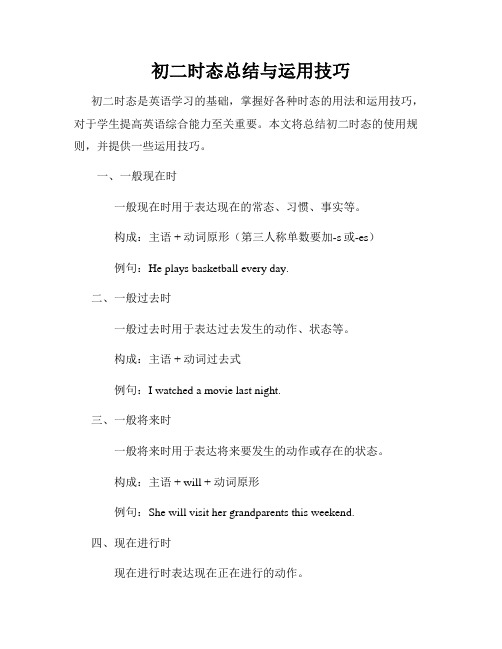
初二时态总结与运用技巧初二时态是英语学习的基础,掌握好各种时态的用法和运用技巧,对于学生提高英语综合能力至关重要。
本文将总结初二时态的使用规则,并提供一些运用技巧。
一、一般现在时一般现在时用于表达现在的常态、习惯、事实等。
构成:主语 + 动词原形(第三人称单数要加-s或-es)例句:He plays basketball every day.二、一般过去时一般过去时用于表达过去发生的动作、状态等。
构成:主语 + 动词过去式例句:I watched a movie last night.三、一般将来时一般将来时用于表达将来要发生的动作或存在的状态。
构成:主语 + will + 动词原形例句:She will visit her grandparents this weekend.四、现在进行时现在进行时表达现在正在进行的动作。
构成:主语 + am/is/are + 动词-ing例句:They are playing football in the park.五、过去进行时过去进行时表达过去某一时刻正在进行的动作。
构成:主语 + was/were + 动词-ing例句:He was studying when I called him.六、现在完成时现在完成时用于表达过去发生的动作对现在造成的影响或结果。
构成:主语 + have/has + 动词过去分词例句:I have finished my homework.七、过去完成时过去完成时用于表达过去某一时间或动作之前已经完成的动作或状态。
构成:主语 + had + 动词过去分词例句:She had already left when I arrived.八、将来完成时将来完成时用于表达将来某一时间或动作之前将要完成的动作或状态。
构成:主语 + will have + 动词过去分词例句:We will have finished the project by next month.九、情态动词情态动词包括can、could、may、might、must、shall、should、will、would等,用于表达各种不同的能力、可能性、必要性等。
初中八大时态总结
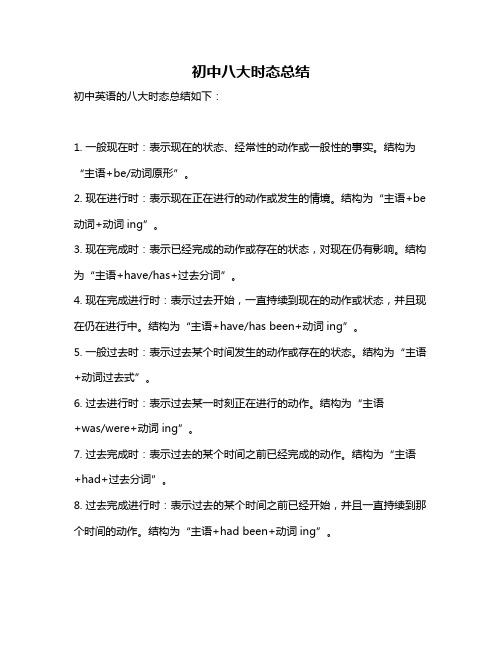
初中八大时态总结
初中英语的八大时态总结如下:
1. 一般现在时:表示现在的状态、经常性的动作或一般性的事实。
结构为“主语+be/动词原形”。
2. 现在进行时:表示现在正在进行的动作或发生的情境。
结构为“主语+be 动词+动词ing”。
3. 现在完成时:表示已经完成的动作或存在的状态,对现在仍有影响。
结构为“主语+have/has+过去分词”。
4. 现在完成进行时:表示过去开始,一直持续到现在的动作或状态,并且现在仍在进行中。
结构为“主语+have/has been+动词ing”。
5. 一般过去时:表示过去某个时间发生的动作或存在的状态。
结构为“主语+动词过去式”。
6. 过去进行时:表示过去某一时刻正在进行的动作。
结构为“主语
+was/were+动词ing”。
7. 过去完成时:表示过去的某个时间之前已经完成的动作。
结构为“主语+had+过去分词”。
8. 过去完成进行时:表示过去的某个时间之前已经开始,并且一直持续到那个时间的动作。
结构为“主语+had been+动词ing”。
以上是初中英语八大时态的总结,希望对你有所帮助。
八年级英语语法常用时态的总结
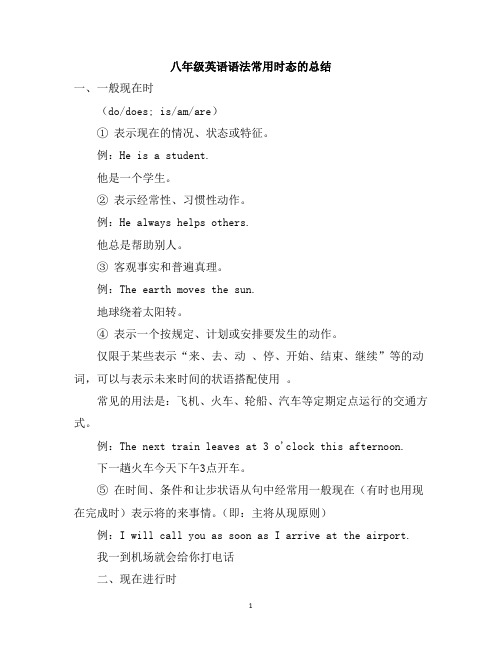
八年级英语语法常用时态的总结一、一般现在时(do/does; is/am/are)①表示现在的情况、状态或特征。
例:He is a student.他是一个学生。
②表示经常性、习惯性动作。
例:He always helps others.他总是帮助别人。
③客观事实和普遍真理。
例:The earth moves the sun.地球绕着太阳转。
④表示一个按规定、计划或安排要发生的动作。
仅限于某些表示“来、去、动、停、开始、结束、继续”等的动词,可以与表示未来时间的状语搭配使用。
常见的用法是:飞机、火车、轮船、汽车等定期定点运行的交通方式。
例:The next train leaves at 3 o'clock this afternoon.下一趟火车今天下午3点开车。
⑤在时间、条件和让步状语从句中经常用一般现在(有时也用现在完成时)表示将的来事情。
(即:主将从现原则)例:I will call you as soon as I arrive at the airport.我一到机场就会给你打电话二、现在进行时(am/is/are doing)①表示此时此刻正在发生的事情。
例:He is listning to the music now.他现在正在听音乐。
②表示目前一段时间内一直在做的事情,但不一定此时此刻正在做。
例:I am studying computer this term.这个学期我一直在学习计算机。
③现在进行时可以表示将来的含义。
a. 瞬时动词的进行一定表将来。
例:I am leaving.我要离开了。
b. 持续动词的进行只有有将来的时间状语或有将来语境中才表将来。
例:I am travelling next month.下个月我要去旅行。
④现在进行时与频度副词连用,表示说话者或褒义或贬义的感情色彩。
例:He is always helping others.他总是帮助别人。
(褒义)三、现在完成时(have/has done)①表示动作到现在为止已经完成或刚刚完成,强调对现在产生的影响。
初中英语8个时态归纳总结
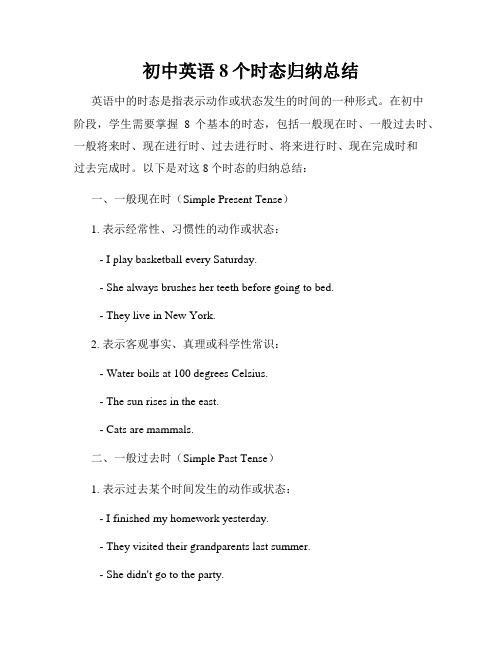
初中英语8个时态归纳总结英语中的时态是指表示动作或状态发生的时间的一种形式。
在初中阶段,学生需要掌握8个基本的时态,包括一般现在时、一般过去时、一般将来时、现在进行时、过去进行时、将来进行时、现在完成时和过去完成时。
以下是对这8个时态的归纳总结:一、一般现在时(Simple Present Tense)1. 表示经常性、习惯性的动作或状态:- I play basketball every Saturday.- She always brushes her teeth before going to bed.- They live in New York.2. 表示客观事实、真理或科学性常识:- Water boils at 100 degrees Celsius.- The sun rises in the east.- Cats are mammals.二、一般过去时(Simple Past Tense)1. 表示过去某个时间发生的动作或状态:- I finished my homework yesterday.- They visited their grandparents last summer.- She didn't go to the party.2. 表示过去的经历或习惯:- When I was young, I often went swimming. - He always ate breakfast at 8 o'clock.三、一般将来时(Simple Future Tense)1. 表示将来要发生的动作或事件:- I will go shopping tomorrow.- They are going to have a picnic next week. - She won't be late for the meeting.2. 表示将来的打算或意愿:- I am going to be a doctor when I grow up.- We will help you with your project.四、现在进行时(Present Continuous Tense)1. 表示现在正在进行的动作:- We are studying English at the moment.- He is playing soccer with his friends.- They aren't watching TV right now.2. 表示现阶段的趋势或变化:- The population is increasing rapidly.- More and more people are using smartphones.五、过去进行时(Past Continuous Tense)1. 表示过去某一时间段内正在进行的动作:- I was reading a book when the phone rang.- They were cooking dinner at 7 o'clock.2. 表示过去的同时发生的两个动作:- She was listening to music while doing her homework.六、将来进行时(Future Continuous Tense)1. 表示将来某一时间段内正在进行的动作:- Tomorrow, they will be flying to Paris.- I will be waiting for you at the station.2. 表示将来的预测或计划:- This time next month, I will be studying for my exams.七、现在完成时(Present Perfect Tense)1. 表示过去某一时间发生的动作对现在造成的影响或结果: - I have finished my homework, so I can watch TV now.- She has already eaten lunch.2. 表示过去某一时间内多次发生的动作:- We have visited that museum several times.八、过去完成时(Past Perfect Tense)1. 表示过去某一时间点之前已经完成的动作:- By the time they arrived, we had already left.- I had finished my work before the deadline.2. 表示过去的顺序或先后关系:- She realized that she had forgotten her keys after she locked the door.以上是初中英语的8个时态的归纳总结。
八年级英语时态总结
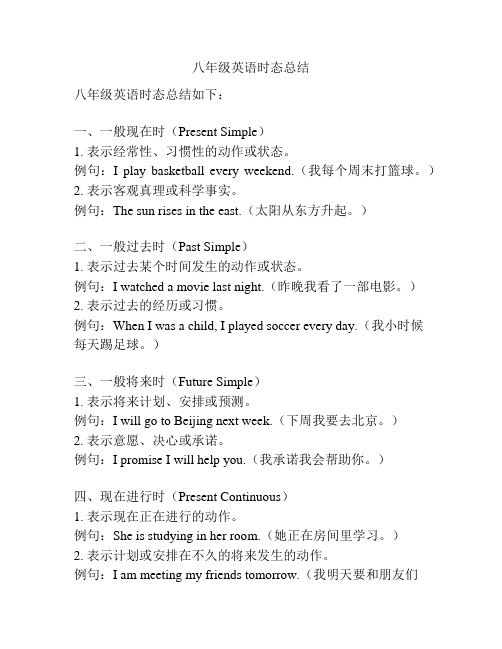
八年级英语时态总结八年级英语时态总结如下:一、一般现在时(Present Simple)1. 表示经常性、习惯性的动作或状态。
例句:I play basketball every weekend.(我每个周末打篮球。
)2. 表示客观真理或科学事实。
例句:The sun rises in the east.(太阳从东方升起。
)二、一般过去时(Past Simple)1. 表示过去某个时间发生的动作或状态。
例句:I watched a movie last night.(昨晚我看了一部电影。
)2. 表示过去的经历或习惯。
例句:When I was a child, I played soccer every day.(我小时候每天踢足球。
)三、一般将来时(Future Simple)1. 表示将来计划、安排或预测。
例句:I will go to Beijing next week.(下周我要去北京。
)2. 表示意愿、决心或承诺。
例句:I promise I will help you.(我承诺我会帮助你。
)四、现在进行时(Present Continuous)1. 表示现在正在进行的动作。
例句:She is studying in her room.(她正在房间里学习。
)2. 表示计划或安排在不久的将来发生的动作。
例句:I am meeting my friends tomorrow.(我明天要和朋友们见面。
)五、过去进行时(Past Continuous)1. 表示过去某一时刻正在进行的动作。
例句:He was reading a book when I entered the room.(我进屋的时候他正在读书。
)2. 表示过去同时发生的两个动作。
例句:I was cooking while he was watching TV.(他在看电视的时候我在做饭。
)六、将来进行时(Future Continuous)表示将来某个时间正在进行的动作。
初二英语时态讲解

初二英语时态讲解初二阶段通常涉及英语中基本的时态,这些时态包括:1. 一般现在时(Simple Present):表示习惯性动作、客观真理、现在的状态等。
一般形式动词原形,第三人称单数加s。
- 例句:She plays basketball every evening.2. 一般过去时(Simple Past):表示过去发生的动作或状态。
动词过去式的使用。
- 例句:They visited London last summer.3. 一般将来时(Simple Future):表示将来发生的动作或状态。
使用情况包括将来计划、打算或预测。
- 例句:I will go to the park tomorrow.4. 现在进行时(Present Continuous):表示现在正在进行的动作。
使用“be”动词(am/is/are)+ 动词的现在分词形式(-ing)构成。
- 例句:They are studying for the exam now.5. 过去进行时(Past Continuous):表示过去某一时刻正在进行的动作。
使用“was/were”+ 动词的现在分词形式(-ing)构成。
- 例句:She was reading a book at this time yesterday.6. 将来进行时(Future Continuous):表示将来某一时刻正在进行的动作。
使用“will be”+ 动词的现在分词形式(-ing)构成。
- 例句:Tomorrow at 8 PM, they will be having dinner.在初二阶段,学生通常开始学习这些基本时态的用法,理解它们的时间表达方式,并能够在简单句子中正确运用。
通过练习和例句,学生可以逐渐熟悉这些时态的结构和用法,为后续语法学习打下坚实基础。
- 1、下载文档前请自行甄别文档内容的完整性,平台不提供额外的编辑、内容补充、找答案等附加服务。
- 2、"仅部分预览"的文档,不可在线预览部分如存在完整性等问题,可反馈申请退款(可完整预览的文档不适用该条件!)。
- 3、如文档侵犯您的权益,请联系客服反馈,我们会尽快为您处理(人工客服工作时间:9:00-18:30)。
时态,简单理解就是根据句子的时间及其暗示词语确定动词的形式。
下面将已学过的一般现在时、一般过去时、一般将来时、现在进行时、现在完成时和过去进行时进行系统归纳,以帮助同学们更好地掌握它们。
一、一般现在时
一般现在时表示经常性的行为、意愿、状态及客观真理等。
它的时间状语一般为every day / week / month / year之类的短语或always,often,sometimes,usually,seldom等表示频率的词。
动词形式一般为原形;如果主语是he / she / it(或单数名词)等第三人称单数,动词要变为第三人称单数形式,以do为例,即改为does。
例如:
My pen friend always writes to me on Saturday. 我的笔友经常在星期六给我写信。
二、一般过去时
一般过去时表示过去的行为或状态。
它的时间状语一般为last day / week / month / year,yesterday,the day before yesterday等表示过去具体时间的词或after, some time ago / later等。
动词形式要用过去式,以do为例,即改为did。
例如:
He worked very hard at Chinese last year. 他去年很努力地学习语文。
三、一般将来时
一般将来时表示将来的动作或存在的状态,它的时间状语一般为next week / month / year等或tomorrow,the day after tomorrow,in the future等。
时态构成为“will / be going to + 动词原形”。
例如:
I’m going to write it down in my diary tomorrow. 明天我将把它写到日记里。
四、现在进行时
现在进行时表示现在或现阶段正在进行的动作。
它的时间状语一般为now (= at the moment)。
时态构成为:be + 动词的现在分词。
例如:What is she doing now / at the moment? 她正在做什么?
五、现在完成时
用法主要有两种:a. 表示过去发生或已经完成的某一动作对现在造成的影响或结果;b. 表示从过去某个时间开始一直延续到现在(可能还要继续下去)
的动作或状态。
现在完成时由“助动词have / has+过去分词”构成。
例如:
—Have you learned Italian?
—Yes, I have. I have learned Italian for two years. / No, I haven’t. I haven’t learned Italian.
现在完成时的句子通常有哪些暗示词语呢?
1、在肯定句中通常有just,already,ever等。
例如:
She has already been to Beijing twice. 她已去过北京两次了。
2、在否定句或疑问句中通常有yet,ever,never,before等。
例如:
—Has he ever been there before? —No, never.
—他以前去过那儿吗?—不, 从来没有。
3、肯定句变为否定句或疑问句时,already要改为yet,而且一般放在句末。
I have already finished reading that book. 我已经读完那本书了。
I haven’t finished reading that book yet.我还没写完呢。
4、在现在完成时中,我们经常使用since表示过去发生并一直持续到现在的事情。
since的意思是“自从……”,既可作介词,又可作连词。
作介词时,后接“点”时间,表示某事开始的时间;作连词时,常用来引导时间状语从句。
通常,主句用现在完成时,从句用一般过去时。
例如:
He hasn’t been home since 1990. 他从1990年起就没回过家。
She has lived in Beijing since she was a child. 她从小就住在北京。
5、注意for在现在完成时中的用法。
for后接“段”时间,表示某种现有状况已经持续了一段时间。
例如:
We have already studied English for five years. 我们已经学了五年英语了。
His grandfather has been dead for ten years. 他爷爷已经去世十年了。
